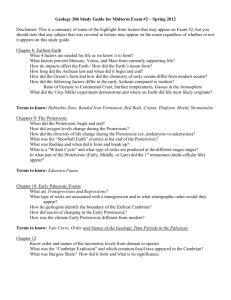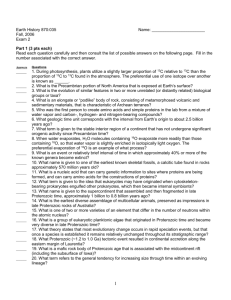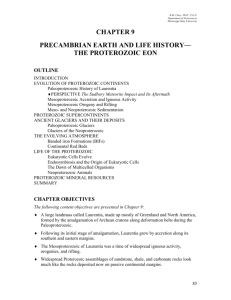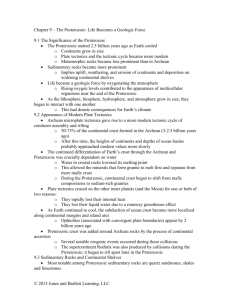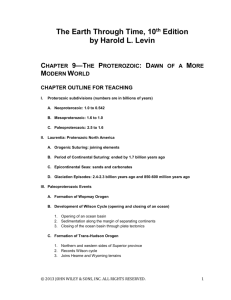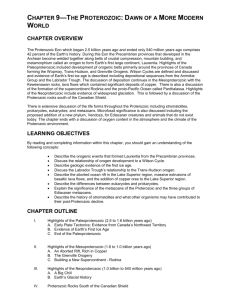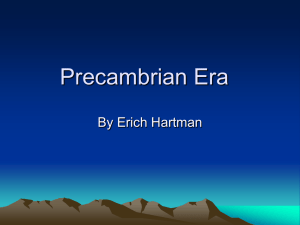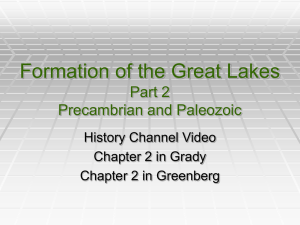Ch 9 Objectives and Summaries Answers
advertisement
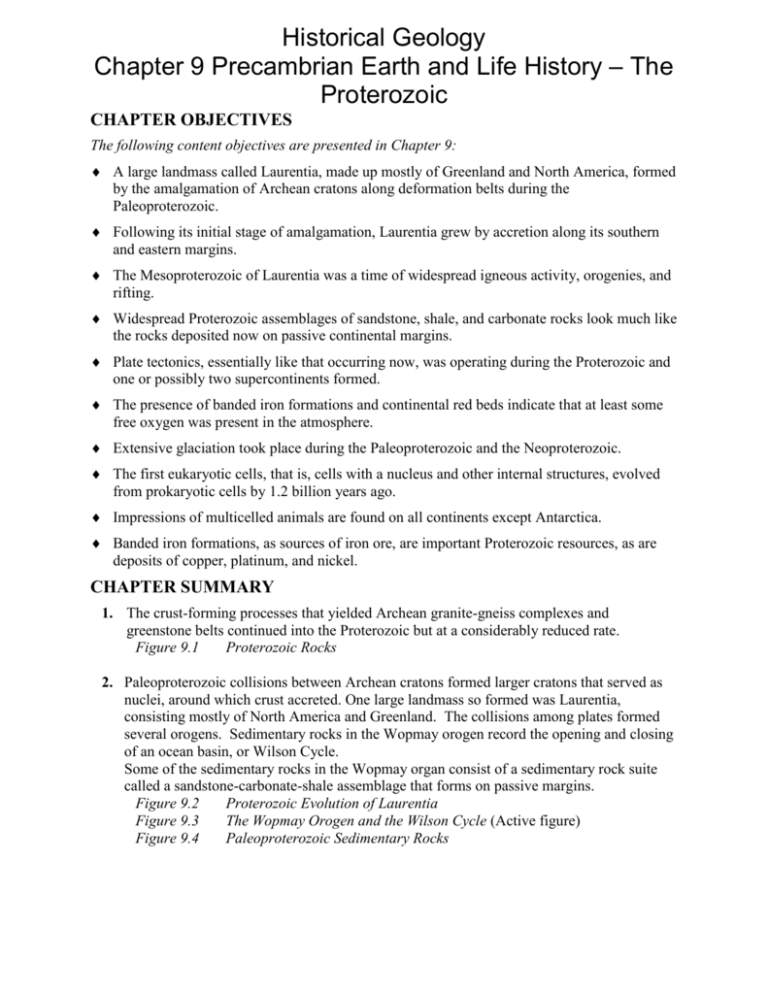
Historical Geology Chapter 9 Precambrian Earth and Life History – The Proterozoic CHAPTER OBJECTIVES The following content objectives are presented in Chapter 9: A large landmass called Laurentia, made up mostly of Greenland and North America, formed by the amalgamation of Archean cratons along deformation belts during the Paleoproterozoic. Following its initial stage of amalgamation, Laurentia grew by accretion along its southern and eastern margins. The Mesoproterozoic of Laurentia was a time of widespread igneous activity, orogenies, and rifting. Widespread Proterozoic assemblages of sandstone, shale, and carbonate rocks look much like the rocks deposited now on passive continental margins. Plate tectonics, essentially like that occurring now, was operating during the Proterozoic and one or possibly two supercontinents formed. The presence of banded iron formations and continental red beds indicate that at least some free oxygen was present in the atmosphere. Extensive glaciation took place during the Paleoproterozoic and the Neoproterozoic. The first eukaryotic cells, that is, cells with a nucleus and other internal structures, evolved from prokaryotic cells by 1.2 billion years ago. Impressions of multicelled animals are found on all continents except Antarctica. Banded iron formations, as sources of iron ore, are important Proterozoic resources, as are deposits of copper, platinum, and nickel. CHAPTER SUMMARY 1. The crust-forming processes that yielded Archean granite-gneiss complexes and greenstone belts continued into the Proterozoic but at a considerably reduced rate. Figure 9.1 Proterozoic Rocks 2. Paleoproterozoic collisions between Archean cratons formed larger cratons that served as nuclei, around which crust accreted. One large landmass so formed was Laurentia, consisting mostly of North America and Greenland. The collisions among plates formed several orogens. Sedimentary rocks in the Wopmay orogen record the opening and closing of an ocean basin, or Wilson Cycle. Some of the sedimentary rocks in the Wopmay organ consist of a sedimentary rock suite called a sandstone-carbonate-shale assemblage that forms on passive margins. Figure 9.2 Proterozoic Evolution of Laurentia Figure 9.3 The Wopmay Orogen and the Wilson Cycle (Active figure) Figure 9.4 Paleoproterozoic Sedimentary Rocks Historical Geology Chapter 9 Precambrian Earth and Life History – The Proterozoic 3. Paleoproterozoic amalgamation of cratons, followed by Mesoproterozoic igneous activity, the Grenville orogeny, and the Midcontinent rift, were important events in the evolution of Laurentia. Figure 9.5 Rocks of the Grenville Orogen Figure 9.6 The Midcontinent Rift Figure 9.7 Proterozoic Rocks in the Western United States and Canada 4. Sandstone-carbonate-shale assemblages deposited on passive continental margins were very common by Proterozoic time. 5. Ophiolite sequences marking convergent plate boundaries are first well documented from the Neoarchean and Paleoproterozoic, indicating that a plate tectonic style similar to that operating now had become established. Figure 9.8 The Jormua Mafic-Ultramafic Complex in Finland 6. The supercontinent Rodinia assembled between 1.3 and 1.0 billion years ago, fragmented, and then reassembled to form Pannotia about 650 million years ago, which began fragmenting about 550 million years ago. Figure 9.9 Rodinia 7. Glaciers were widespread during both the Paleoproterozoic and the Neoproterozoic. Figure 9.10 Paleo- and Neoproterozoic Glaciers Figure 9.11 Proterozoic Glaciation Enrichment Topic 1. Snowball Earth The hypothesis rests on evidence of glaciers in tropical regions, only 11 degrees from the equator, such as Panama today. It is hypothesized that because tropical glaciers existed, it is likely that glaciers covered the landmasses of the entire globe. “Snowball Earth,” was repeated at least once more 700 million years ago, when glaciers were even closer to the equator. The plummeting temperatures were likely caused by a lack of carbon dioxide, which may have been utilized and removed by abundant plants. A large event—such as a volcanic eruption, a meteorite impact, or the sudden release of frozen methane deposits—would be needed to release carbon dioxide into the atmosphere. Science News, March 29, 1997 v.151 n.13 p.196. 8. Photosynthesis continued to release free oxygen into the atmosphere, which became increasingly rich in oxygen through the Proterozoic. 9. Fully 92% of Earth’s iron ore deposits in the form of banded iron formations (BIFs) were deposited between 2.5 and 2.0 billion years ago. Figure 9.11 Paleoproterozoic Banded Iron Formation (BIF) Historical Geology Chapter 9 Precambrian Earth and Life History – The Proterozoic Enrichment Topic 2. Elements and Evolution The bulk of Earth’s surface is covered by ocean regions, where life is scarce. Although thinlypopulated ecosystems do not lack in energy (sunshine), water, or the basic building blocks (carbon, hydrogen, oxygen, nitrogen), they are deficit in other elements needed to sustain life. Massive deposits of Banded Iron Formations (BIFs) changed the environmental chemistry of the oceans. Whereas the oceans were rich in iron during the first half of Earth history, iron is scarce in oceans today. It is often called a limiting nutrient. Sulfur was also affected. Other changes in bioessential elements are more subtle, but the changing environment affected manganese, cobalt, nickel, copper, zinc, and molybdenum. Changes in the chemical composition of the ocean affected the biosphere as well. A. Anbar, “Elements and Evolution.” Science, December 5, 2008, v. 322, p. 1481-1483. 10. Continental red beds appeared about 1.8 billion years ago, and indicate that Earth’s atmosphere had enough free oxygen for oxidation of iron compounds. 11. Most of the known Proterozoic organisms are single-celled prokaryotes (bacteria). When eukaryotic cells first appeared is uncertain, but they were probably present by 2.1 billion years ago. Endosymbiosis is a widely accepted theory for their origin. Figure 9.12 Proterozoic Fossil Bacteria and Stromatolites Figure 9.13 Prokaryotic and Eukaryotic Cells Table 9.1 The Six-Kingdom Classification of Organisms Figure 9.14 The Three Domain Classification System Figure 9.15 The Oldest Known Eukaryote and Megafossil Figure 9.16 Proterozoic Fossils Figure 9.17 Endosymbiosis and the Origin of Eukaryotic Cells 12. Multicelled organisms were present by the Neoproterozoic, but the fossil record does not tell us how the transition took place. Figure 9.18 Single Celled and Multicelled Organisms 13. The first controversy-free fossils of animals come from the Ediacaran fauna of Australia and other locations. Animals were widespread at this time, but because all lacked durable skeletons their fossils are not common. Figure 9.19 The Ediacaran Fauna of Australia Figure 9.20 Ediacaran-type Fossils from Mistaken Point Formation of Newfoundland Figure 9.21 Neoproterozoic Fossils 14. Most of the world’s iron ore production is from Proterozoic banded iron formations. Other important resources include nickel and platinum. Figure 9.22 Iron Mining from the Lake Superior Region
